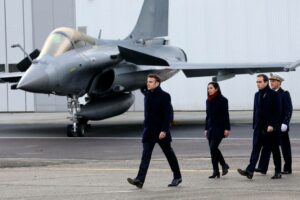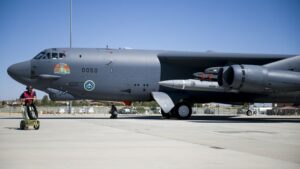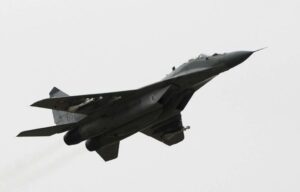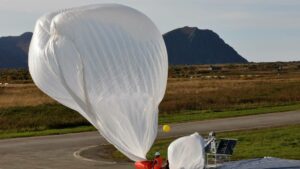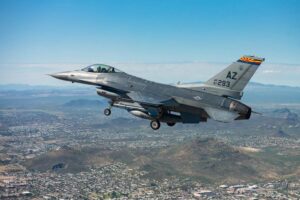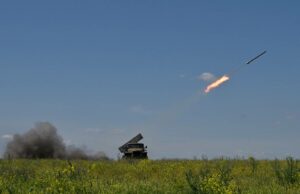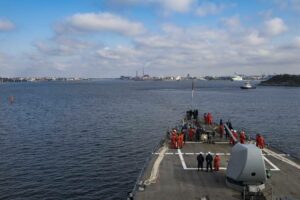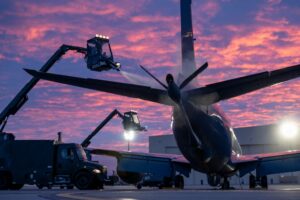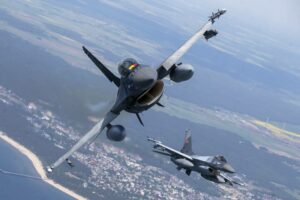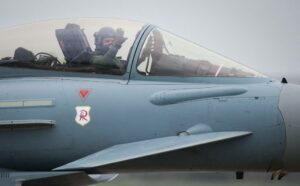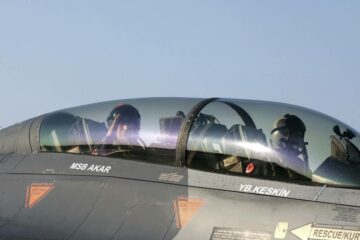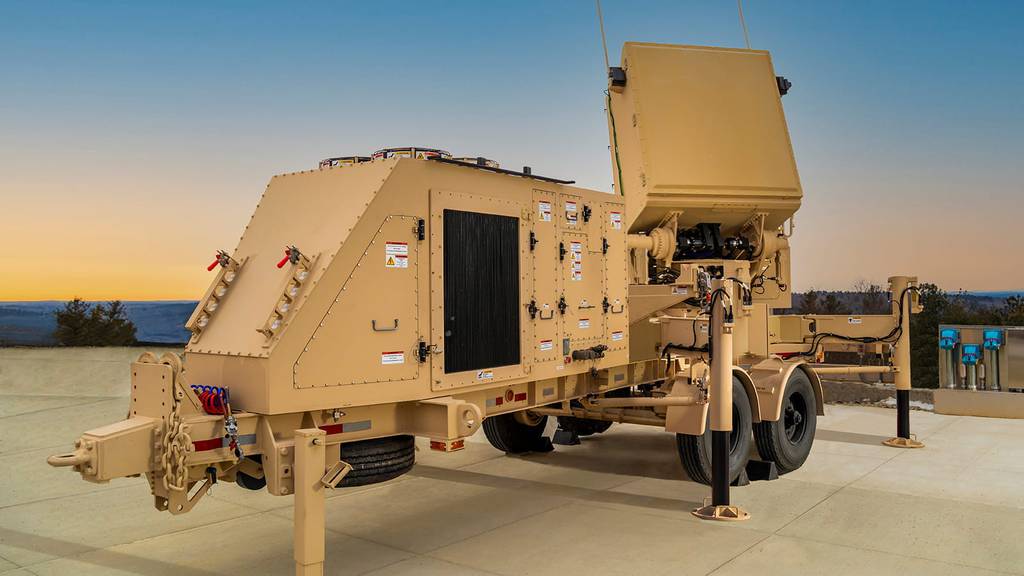
WASHINGTON — The U.S. Air Force can start testing a new medium-range sensor next month for the National Advanced Surface-to-Air Missile System thanks to several recently awarded government contracts, RTX said Tuesday.
The $7 million in awards from the Air Force Research Laboratory’s Strategic Development, Planning and Experimentation Office as well as the Office of the Secretary of Defense’s Rapid Prototyping Program will help RTX, formerly known as Raytheon Technologies, move forward on the development and testing of its GhostEye MR radar.
GhostEye MR is a medium-range multimission radar that can detect, track and identify threats including cruise missiles, drones, and fixed- and rotary-wing aircraft. The company said GhostEye MR can both operate as a standalone radar and be integrated with the NASAMS air defense systems used to protect overseas air bases.
The contracts’ total value is small compared to some other government deals. But Joe DeAntona, Raytheon’s vice president of requirements and capabilities for land and air defense systems, told Defense News on Tuesday that the agreements allow the firm to move GhostEye MR out of its own research and development efforts and into more of a Pentagon-involved project.
RTX said the funding will allow an AFRL-run operational test at White Sands Missile Range in New Mexico, now scheduled for September.
In September 2022, the lab and RTX conducted an experiment in Andøya, Norway, to demonstrate how the National Advanced Surface-to-Air Missile System, or NASAMS — made by Norwegian firm Kongsberg Defence and Aerospace alongside RTX — could be used to defend air bases against advanced aerial threats.
The operational assessment next month will build on that experiment by using the Air Force’s command-and-control capabilities to link GhostEye MR with NASAMS’ Fire Distribution Center, RTX said in a release.
GhostEye MR has been in the works for more than three years, DeAntona said. But so far, before receiving these first government contracts last week, the company has funded the system’s development, prototyping and testing through internal R&D, he explained. The company’s prototyping work on GhostEye MR took place at its facilities in New England, including in Andover, Massachusetts, DeAntona said.
DeAntona added that if the government decides it wants to fund and move forward with GhostEye MR, then RTX would be able to start producing the sensors for NASAMS within “months, not years.”
“We’re ready to move forward,” he said. “The technology is matured, the form and function of the radar is done. Now it’s a matter of taking customer feedback and either modifying or delivering what we have to this point based on the customer’s demand signal.”
“This isn’t a PowerPoint slide. We’ve bent the steel,” he added, “and we’ve produced an operational radar to meet the requirements of our warfighters.”
GhostEye MR will be easily transportable and use the latest sensor technology, DeAntona said, and be able to track incoming threats that are both high and fast, as well as low and slow. It also uses modular technologies that will allow the Air Force to operate GhostEye MR in several different configurations, he noted.
RTX also said GhostEye MR shares some technology with the Lower Tier Air and Missile Defense Sensor — another radar in the GhostEye series that RTX is building for the Army, but one the company said has a different mission set than GhostEye MR.
DeAntona said GhostEye MR uses an active electronically scanned array, or AESA, radar made from gallium nitride. RTX has said the semiconductor material used to build radar circuits allows for a stronger and more sensitive, longer-range radar signal, while active electronically scanned array technology provides 360-degree coverage.
RTX also said GhostEye MR has a software-defined aperture, which would allow it to add more capabilities through software upgrades.
The United States uses NASAMS to guard airspace over the National Capital Region, and has sent the launcher and munitions to Ukraine as part of the effort to arm the nation against Russia’s invasion.
Stephen Losey is the air warfare reporter for Defense News. He previously covered leadership and personnel issues at Air Force Times, and the Pentagon, special operations and air warfare at Military.com. He has traveled to the Middle East to cover U.S. Air Force operations.
- SEO Powered Content & PR Distribution. Get Amplified Today.
- PlatoData.Network Vertical Generative Ai. Empower Yourself. Access Here.
- PlatoAiStream. Web3 Intelligence. Knowledge Amplified. Access Here.
- PlatoESG. Automotive / EVs, Carbon, CleanTech, Energy, Environment, Solar, Waste Management. Access Here.
- PlatoHealth. Biotech and Clinical Trials Intelligence. Access Here.
- ChartPrime. Elevate your Trading Game with ChartPrime. Access Here.
- BlockOffsets. Modernizing Environmental Offset Ownership. Access Here.
- Source: https://www.defensenews.com/industry/techwatch/2023/08/30/rtx-readies-to-test-new-air-defense-radar-following-us-air-force-deals/
- :has
- :is
- :not
- 10
- 2022
- 360-degree
- 70
- a
- Able
- active
- add
- added
- advanced
- Aerospace
- against
- agreements
- AIR
- Air Force
- aircraft
- airspace
- allow
- allows
- alongside
- also
- an
- and
- Another
- ARE
- ARM
- Army
- Array
- AS
- assessment
- At
- awarded
- awards
- based
- BE
- been
- before
- both
- build
- Building
- but
- by
- CAN
- capabilities
- capital
- Center
- COM
- company
- Company’s
- compared
- conducted
- contracts
- could
- cover
- coverage
- covered
- cruise
- customer
- deal
- Deals
- defence
- Defense
- delivering
- Demand
- demonstrate
- Development
- different
- distribution
- done
- Drones
- easily
- East
- effort
- efforts
- either
- electronically
- England
- experiment
- explained
- facilities
- far
- FAST
- feedback
- Fire
- Firm
- First
- following
- For
- Force
- form
- formerly
- Forward
- from
- function
- fund
- funded
- funding
- Government
- Guard
- Have
- he
- help
- High
- How
- HTTPS
- identify
- if
- images
- in
- Including
- Incoming
- integrated
- internal
- into
- issues
- IT
- ITS
- joe
- jpg
- known
- lab
- Land
- Last
- latest
- Leadership
- LINK
- Low
- lower
- made
- massachusetts
- material
- Matter
- Meet
- Mexico
- Middle
- Middle East
- Military
- million
- missiles
- Mission
- modular
- Month
- more
- move
- move forward
- mr
- nation
- National
- New
- news
- next
- Norway
- Norwegian
- noted
- now
- of
- Office
- on
- ONE
- operate
- operational
- Operations
- or
- Other
- our
- out
- over
- overseas
- own
- part
- pentagon
- Personnel
- Place
- planning
- plato
- Plato Data Intelligence
- PlatoData
- Point
- president
- previously
- Produced
- producing
- Program
- project
- protect
- prototyping
- provides
- R&D
- radar
- range
- rapid
- ready
- receiving
- recently
- region
- release
- reporter
- Requirements
- research
- research and development
- rtx
- s
- Said
- scheduled
- secretary
- semiconductor
- sensitive
- sensors
- sent
- September
- Series
- set
- several
- Shares
- Signal
- Slide
- slow
- small
- So
- so Far
- Software
- some
- special
- standalone
- start
- States
- steel
- Strategic
- stronger
- system
- Systems
- taking
- Technologies
- Technology
- test
- Testing
- than
- thanks
- that
- The
- then
- These
- this
- threats
- three
- Through
- tier
- times
- to
- took
- Total
- track
- traveled
- Tuesday
- u.s.
- U.S. Air Force
- Ukraine
- United
- United States
- upgrades
- us
- use
- used
- uses
- using
- value
- vice
- Vice President
- wants
- we
- week
- WELL
- What
- which
- while
- white
- will
- with
- within
- Work
- works
- would
- years
- zephyrnet

